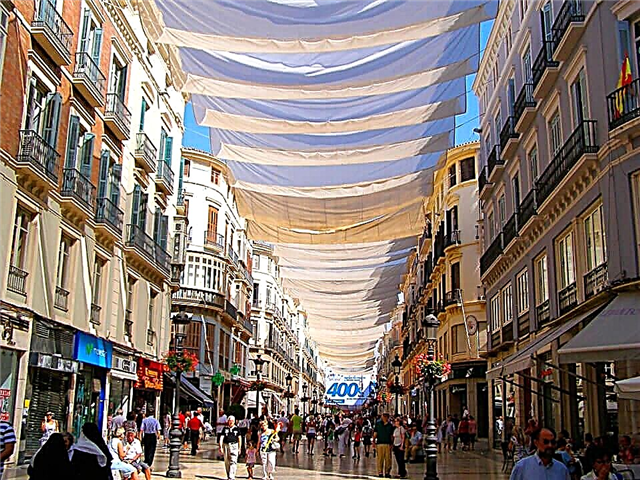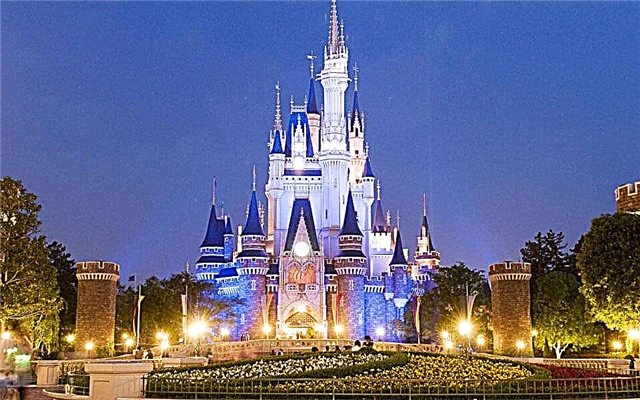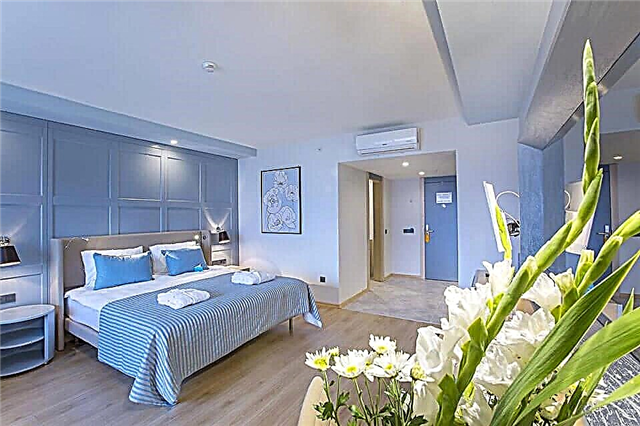Route: Vokzalnaya Square - Kooperativnaya Street - Red Army Avenue - Karl Marx Street - Ovrazhny Lane - Vokzalny Lane - Sergievskaya Street.
Length: 3.5 km
Monument to Savva Ivanovich Mamontov at the station square
The route of the excursion around the ancient city of the Golden Ring of Russia - Sergiev Posad is convenient to start from Vokzalnaya Square. Electric trains come here from Moscow, and here, on the square, there is a bus station, where buses arrive, connecting Sergiev Posad with the capital and surrounding villages. The station square is very well-groomed, it is built up with two-storey buildings, and many different shops are open on it, including souvenir shops.
A monument to the Russian philanthropist Savva Ivanovich Mamontov is erected near the station building. His father was the manager of the Moscow-Yaroslavl railway. The same position was held by Savva Mamontov himself. Thanks to the efforts of S.I. Mamontov and the funds invested by him, the railway developed and was extended to Arkhangelsk.
Church of the Ascension of the Lord on Red Army Avenue
From Vokzalnaya Square, you need to go to the beginning of Kooperativnaya Street and walk along it to Red Army Avenue (about 400 m). Sergiev Posad is a small and cozy city built on the hills. Many buildings of the late 19th - early 20th centuries have survived on its streets. Such two-story houses also stand along the Red Army Avenue - the longest and widest highway in the city.
In the 18th century, this street was called Bolshedorozhnaya and was part of the route from Moscow to Pereslavl-Zalessky. In those days, the roadway was paved only in the dampest places, and the owners of the houses standing along it had to monitor the quality and cleanliness of the road.
Entrance to the Toy Museum
At the crossroads, you need to cross the Red Army Avenue to the other side and walk along it to the right in a northern direction. In the distance you will see the domes of the Trinity-Sergius Lavra.
On the way, you can meet a lot of remarkable things. For example, the beautiful blue and white Church of the Ascension of the Lord, built in the second half of the 18th century. The decoration of this temple is made in the best traditions of the mature baroque. At one time, there was a large Voznesenskaya Square in front of it, which had the status of the administrative center of a provincial city.
Monument to Saints Peter and Fevronia of Murom
On the left side, at 123, there is one of the city's most interesting museums - the Toy Museum. It was established in Moscow and moved to Sergiev Posad in 1931. In the halls of the museum you can see dolls and mechanical toys used by the children of the last Russian emperor Nicholas II. The museum displays traditional toys from Western Europe and Asia, musical toys and designer dolls. A large section is devoted to board games and toys produced in Soviet times.
From the building of the museum, the Red Army Avenue begins a noticeable descent into the lowland, along which the small river Konchura flows. On the left, on its tributary, the Kopninka, there are two large ponds - Kelarsky and Banny. 80 m from the avenue, at the lower end of the Kelarsky pond, there is a beautiful monument to Saints Peter and Fevronia of Murom. It is convenient to approach it along Ilinskaya street.
Bridge of the newlyweds across the Kopninka river
Opposite the monument, along the Kopninka riverbed, there is a paved footpath. Nearby, an openwork pedestrian bridge is thrown across the river, on which you can see many locks with names. There is a tradition in the city - the newlyweds fix the locks on the bridge, as a symbol of loyalty and belief that marital relations will be long and happy. And the keys to the cherished locks are thrown by the young husband and wife into the waters of Kopninka.
From the bridge along the footpath, you need to continue going further north. Soon it will lead to a small square with an Eternal Flame - the Glory Memorial, opened in 1950 at the mass grave of Soviet soldiers. Behind it is the Pyatnitskoye courtyard of the Trinity-Sergius Lavra, which includes two ancient temples - the Vvedenskaya church and the temple of Paraskeva Pyatnitsa. The place where they stand was called Podol in the old days. From here, the Lavra opens in all its glory. Its high white walls are very reminiscent of a fortress. And powerful square corner towers and narrow slots of loopholes further enhance this impression.
Memorial of Glory with Eternal Flame
The entrance to the Trinity-Sergius Lavra is located near a wide square adjacent to the Red Army Avenue. You can get to the territory through the Holy Gates. Both pilgrims and tourists who are interested in history and Russian architecture go to the Lavra. You can travel around the monastery on your own and as part of excursion groups. Part of the territory where the monks live is closed to guests.
In addition to visiting churches and Orthodox shrines, many come here to take water from a holy spring, relax near flowering flower beds, take pictures, and also visit unique museums. In the building of the Sacristy, you can see a collection of rare icons, church manuscripts, liturgical utensils and textiles. Another museum is located in the premises of the Royal Palaces, which are owned by the Moscow Orthodox Theological Academy. It is called the "Church-Archaeological Office". In 12 halls of this museum, ancient icons, books and things that belonged to church hierarchs are exhibited.
Pyatnitskoye courtyard of the Trinity-Sergius Lavra. From left to right: Temple of Paraskeva Pyatnitsa, Vvedenskaya Church
Going to the Lavra, you need to understand how important this shrine is for Orthodox Christians. Therefore, regardless of the purpose of visiting it, you should respect local traditions and follow certain rules. In the Lavra one should not make noise, talk loudly and smoke, and clothes should not be provocative and too open.
There is a convenient underground passage opposite the entrance to the Lavra through Red Army Avenue. On it you need to go to the opposite side of the street and continue walking along it in a northern direction until the intersection with Karl Marx Street. On the way to the right, on the east side of the avenue, you will see a monument to the parents of Sergius of Radonezh, standing in the middle of a small open park. And on the left side, the long red-brick building of the New Trading Rows attracts attention.
View of the Trinity-Sergius Lavra
Karl Marx Street is noticeably narrower than Red Army Avenue. The buildings at its beginning have long belonged to the Trinity-Sergievsky Lavra. There is a new monastery hotel and an old hospice, or as it was called before, the House of Priesthood, which was under the patronage of Empress Maria Feodorovna. In the courtyard you can see an elegant one-domed two-story church of the Nativity of the Blessed Virgin Mary, built in the pseudo-Russian style in the 70s of the XIX century.
After passing 150 m along Karl Marx Street, you need to turn right into a narrow Ovrazhny lane, where the city museum of local lore is located in building 9A - one of the departments of the historical and art museum of the reserve. People come here to get acquainted with the history of Sergiev Posad. The museum is small, and one hour will be enough to explore it.
Monument to the Venerable Parents of Sergius of Radonezh Kirill and Mary
Part of the exposition tells about the role of the railway for the city, because before it was laid through Sergiev Posad, pilgrims spent three days or more on the way to the monastery from Moscow. The first station built here was called "Sergievo". Another section of the museum tells about the traditional crafts and activities of the local people. The city has long been famous for its excellent furniture makers. In addition, it was here that a Russian nesting doll was first mass-cut out. At the time when Sergiev Posad was called Zagorsk, industrial enterprises began to develop there.
From the museum it is necessary to return to the railway station, from where the city tour began. This can be done along Ovrazhny and Vokzalny lanes, and Sergievskaya street. This part of the city is less "official" than the development along the Red Army Avenue.
Museum of local lore
Gully and Vokzalny lanes pass through the territory of private one-two-story wooden and stone households, a significant part of which are mini-hotels and guest houses. It is very green here, and beautiful carved frames have been preserved on many buildings. For example, in houses 6, 17 and 19 on Ovrazhny Lane.
The way from the local history museum to Vokzalnaya square takes 15-20 minutes (just over 1 km).











